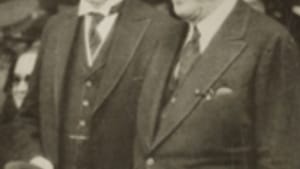Stay in the Loop
BSR publishes on a weekly schedule, with an email newsletter every Wednesday and Thursday morning. There’s no paywall, and subscribing is always free.
Back to the future in Cuba: If Calvin Coolidge could do it…
What might have been: Coolidge in Cuba

It was mid-January 1928 when President Coolidge boarded his presidential rail car for the 32-hour trip to Key West and then boarded the U.S.S. Texas for the overnight to Havana. He was en route to give the opening address at the Pan American Conference (Organization of American States).
Traveling with the president were several journalists and notables, H.L. Mencken and Will Rogers among them. Archival footage shows "our man in Havana" surrounded by bodyguards, enjoying the fanfare. Thirty years later the Saturday Evening Post ran Beverly Smith's "To Cuba With Cal," including several remarkable photos of Coolidge with Cuban President Machado and their first ladies.
The President gave quite the address, hardly the few words you might have expected from "Silent Cal." Despite Coolidge's unfortunate references to Columbus, nowhere beloved in Latin America, the address is remarkable for it otherwise courteous respect for the Americas. For instance:
Marines in Nicaragua
"Thirty years ago Cuba ranked as a foreign possession…. Today Cuba is her own sovereign. Her people are independent, free, prosperous and peaceful, enjoying the advantages of self-government…. What Cuba has done, others have done and are doing…. Among our republics… people have taken charge of their own affairs… an attitude of peace and goodwill prevails among our nations."
Truth be told, there was plenty of trouble in Nicaragua, where U.S. Marines had been deployed since 1912. The nationalist Augusto Sandino didn't care much for foreign interference, least of all foreign troops. The Marines were withdrawn in 1925, but then sent back again in 1926.
For Coolidge, governing was all about delegating. If there was trouble in Central America, dispatch Secretary Henry Stimson to settle things. If there was a problem with policy, enlist the Sate Department's legal adviser, J. Reuben Clark, to fix it.
A José Martí fantasy
To his credit, Clark argued that the Monroe Doctrine was aimed at Europe, not American nations. While the Clark Memorandum wasn't considered official U.S. foreign policy, it resonated with Coolidge and set the tone for his remarks in Havana.
Had José Martí not been killed in 1895, fighting for Cuban independence, an elderly José would have been there at age 75 to welcome Coolidge. No doubt Martí would have given him a copy of his essay, Our America, and invited the president to see more of historic Havana: its National Assembly (modeled after the U.S. Capitol), its National Theater (site of the Pan Am Conference), the Malecon….
He might have taken Coolidge to visit nearby Hershey, Cuba— developed ten years earlier by Milton Hershey and serviced by an electric rail line (using Brill cars made in Philadelphia). Then Martí would have sought some private time with the president to discuss the lingering problem of Guantánamo and the U.S. military presence on sovereign Cuba.
Simple request
Citing Frederick Douglass's brief stint as the U.S. emissary to Haiti (1889)— when Douglas discussed, but wouldn't force, the issue of a U.S. coaling station at MÓ´le St. Nicholas in Haiti— Martí might have found the words to persuade President Coolidge to vacate Guantanamo. The Republic of Cuba, after all, was not asking for a reciprocal base in south Florida, simply for a U.S. withdrawal from independent Cuba.
Citing the President's kind words for the emerging, maturing democracies throughout the Americas, Martí would have made the case for an all the more secure community of nations, based on trust and good will— not force.
When we look at the two major biographies of Coolidge, we find hardly a mention of Coolidge's visit and speech in Havana. Why? Does the U.S. embargo on Cuba extend to any mention of our 30th president's visit there?
Books for Obama
Come 2028, the Organization of American States might indeed choose to hold its conference in Cuba and perhaps show a segment of John Karol's unfinished documentary on Coolidge, if not additional clips from the Cuban film archives.
(Karol has worked for more than two decades on his three-hour documentary, Things of the Spirit, and it's now nearing completion, funds permitting.)
Three years ago, following the OAS meeting in Trinidad, President Obama was given a much-publicized book by the Latin American author Eduardo Galeano. He was also given a copy of Martí's Our America. Has he found the time to read either? Evidence suggests he may have.
16 years from now
In a June 2011 speech, Obama was very clear: "America stands not for empire, but for self-determination." Coolidge might find in these nine words a foreign policy he could endorse— a fair and principled policy, clearly lost on Teddy Roosevelt but not on other U.S. presidents.
In the year 2028, will the OAS decide to meet in Havana and, if so, invite the U.S. president to present the opening remarks? This would be a gracious way to mark the 100th anniversary of President Calvin Coolidge's speech there.
"Let us be known for our constructive Americanism," wrote José Martí. Is it too much to hope that, by 2028, the assembled OAS members will mark and celebrate the return of the Quantanamo Naval Yard to Cuba, an end to the U.S. embargo, and a more open Cuban society?
Traveling with the president were several journalists and notables, H.L. Mencken and Will Rogers among them. Archival footage shows "our man in Havana" surrounded by bodyguards, enjoying the fanfare. Thirty years later the Saturday Evening Post ran Beverly Smith's "To Cuba With Cal," including several remarkable photos of Coolidge with Cuban President Machado and their first ladies.
The President gave quite the address, hardly the few words you might have expected from "Silent Cal." Despite Coolidge's unfortunate references to Columbus, nowhere beloved in Latin America, the address is remarkable for it otherwise courteous respect for the Americas. For instance:
Marines in Nicaragua
"Thirty years ago Cuba ranked as a foreign possession…. Today Cuba is her own sovereign. Her people are independent, free, prosperous and peaceful, enjoying the advantages of self-government…. What Cuba has done, others have done and are doing…. Among our republics… people have taken charge of their own affairs… an attitude of peace and goodwill prevails among our nations."
Truth be told, there was plenty of trouble in Nicaragua, where U.S. Marines had been deployed since 1912. The nationalist Augusto Sandino didn't care much for foreign interference, least of all foreign troops. The Marines were withdrawn in 1925, but then sent back again in 1926.
For Coolidge, governing was all about delegating. If there was trouble in Central America, dispatch Secretary Henry Stimson to settle things. If there was a problem with policy, enlist the Sate Department's legal adviser, J. Reuben Clark, to fix it.
A José Martí fantasy
To his credit, Clark argued that the Monroe Doctrine was aimed at Europe, not American nations. While the Clark Memorandum wasn't considered official U.S. foreign policy, it resonated with Coolidge and set the tone for his remarks in Havana.
Had José Martí not been killed in 1895, fighting for Cuban independence, an elderly José would have been there at age 75 to welcome Coolidge. No doubt Martí would have given him a copy of his essay, Our America, and invited the president to see more of historic Havana: its National Assembly (modeled after the U.S. Capitol), its National Theater (site of the Pan Am Conference), the Malecon….
He might have taken Coolidge to visit nearby Hershey, Cuba— developed ten years earlier by Milton Hershey and serviced by an electric rail line (using Brill cars made in Philadelphia). Then Martí would have sought some private time with the president to discuss the lingering problem of Guantánamo and the U.S. military presence on sovereign Cuba.
Simple request
Citing Frederick Douglass's brief stint as the U.S. emissary to Haiti (1889)— when Douglas discussed, but wouldn't force, the issue of a U.S. coaling station at MÓ´le St. Nicholas in Haiti— Martí might have found the words to persuade President Coolidge to vacate Guantanamo. The Republic of Cuba, after all, was not asking for a reciprocal base in south Florida, simply for a U.S. withdrawal from independent Cuba.
Citing the President's kind words for the emerging, maturing democracies throughout the Americas, Martí would have made the case for an all the more secure community of nations, based on trust and good will— not force.
When we look at the two major biographies of Coolidge, we find hardly a mention of Coolidge's visit and speech in Havana. Why? Does the U.S. embargo on Cuba extend to any mention of our 30th president's visit there?
Books for Obama
Come 2028, the Organization of American States might indeed choose to hold its conference in Cuba and perhaps show a segment of John Karol's unfinished documentary on Coolidge, if not additional clips from the Cuban film archives.
(Karol has worked for more than two decades on his three-hour documentary, Things of the Spirit, and it's now nearing completion, funds permitting.)
Three years ago, following the OAS meeting in Trinidad, President Obama was given a much-publicized book by the Latin American author Eduardo Galeano. He was also given a copy of Martí's Our America. Has he found the time to read either? Evidence suggests he may have.
16 years from now
In a June 2011 speech, Obama was very clear: "America stands not for empire, but for self-determination." Coolidge might find in these nine words a foreign policy he could endorse— a fair and principled policy, clearly lost on Teddy Roosevelt but not on other U.S. presidents.
In the year 2028, will the OAS decide to meet in Havana and, if so, invite the U.S. president to present the opening remarks? This would be a gracious way to mark the 100th anniversary of President Calvin Coolidge's speech there.
"Let us be known for our constructive Americanism," wrote José Martí. Is it too much to hope that, by 2028, the assembled OAS members will mark and celebrate the return of the Quantanamo Naval Yard to Cuba, an end to the U.S. embargo, and a more open Cuban society?
Sign up for our newsletter
All of the week's new articles, all in one place. Sign up for the free weekly BSR newsletters, and don't miss a conversation.

 John Dowlin
John Dowlin